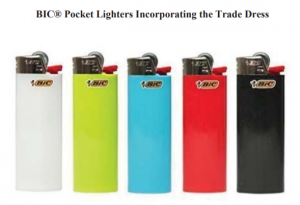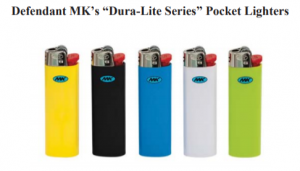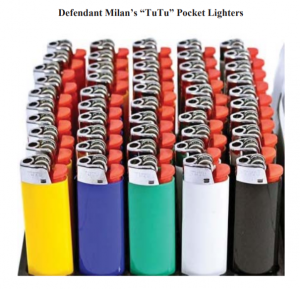 On Thursday, December 6th, Shelton, CT-based pocket lighter maker BIC Corporation filed a Section 337 infringement complaint with the U.S. International Trade Commission (ITC) seeking to stop the importation of pocket lighters infringing upon the trade dress and registered trademarks covering BIC’s well-known lighters. One day earlier, on December 5th, BIC also filed a complaint in the Eastern District of New York asserting similar claims against the same group of defendants, including domestic and foreign entities.
On Thursday, December 6th, Shelton, CT-based pocket lighter maker BIC Corporation filed a Section 337 infringement complaint with the U.S. International Trade Commission (ITC) seeking to stop the importation of pocket lighters infringing upon the trade dress and registered trademarks covering BIC’s well-known lighters. One day earlier, on December 5th, BIC also filed a complaint in the Eastern District of New York asserting similar claims against the same group of defendants, including domestic and foreign entities.
The Section 337 complaint filed with the ITC lists four proposed respondents: Benxi Fenghe Lighter and Zhuoye Lighter Manufacturing, both of China; Wellpine Company of Hong Kong; and MK Lighter of California. The Eastern New York complaint also lists MK Lighter as a defendant along with Milan Import Export Company of California, Excel Wholesale Distributors of New York and a series of individual and company Jane and John Doe defendants.
Both the ITC and the Eastern New York filings note that BIC’s lighter design has been a well-known aspect of American culture for the past 40 years. The lighter designs are covered by federally registered trademarks which protect various aspects of BIC’s trade dress including an oblong body that is elliptical in construction, a fork which is generally parabolic in cross-section and a metal hood which is also generally parabolic in cross-section. Along with the federal trademark registrations, BIC also notes that its lighter design was featured at New York City’s Museum of Modern Art since 2005 as part of an exhibition titled Shaping Modernity: Design 1880-1980.
 Although many readers might be more familiar with patent infringement claims asserted in Section 337 actions at the ITC, BIC Vice President and General Counsel Steve Burkhart notes that trademark and trade dress infringement claims in a Section 337 context aren’t terribly different. “We’ve had our three-dimensional trademark registration for decades,” Burkhart said, adding that one of the defendants in the ITC action was familiar with BIC’s trademark because it was cited as a basis for denying their own trademark application filed with the U.S. Patent and Trademark Office. “Quantitatively, you may see more Section 337 filings on the patent side but there are many examples in the patent and trademark areas where filings encounter denials because of prior art,” Burkhart said.
Although many readers might be more familiar with patent infringement claims asserted in Section 337 actions at the ITC, BIC Vice President and General Counsel Steve Burkhart notes that trademark and trade dress infringement claims in a Section 337 context aren’t terribly different. “We’ve had our three-dimensional trademark registration for decades,” Burkhart said, adding that one of the defendants in the ITC action was familiar with BIC’s trademark because it was cited as a basis for denying their own trademark application filed with the U.S. Patent and Trademark Office. “Quantitatively, you may see more Section 337 filings on the patent side but there are many examples in the patent and trademark areas where filings encounter denials because of prior art,” Burkhart said.
Burkhart noted that in his more than 25 years of experience at BIC, the company has had to assert its intellectual property rights less than a dozen times and mostly in cases where it appeared that infringing products had been diverted from foreign markets. This particular situation was unusual for BIC in that it appeared that a business model based upon infringement had taken root where the defendants have allegedly made molds and selected plastics for their products which they’ve marketed at trade shows. “That’s the opposite of an accident,” Burkhart said. “Really, it’s a different scenario for us.”
While the protection of BIC’s intellectual property is certainly important to the company, Burkhart noted that this case posed serious safety issues that the company wanted to address by keeping infringing articles off the market. The Consumer Product Safety Commission (CPSC) mandates child-resistant lighters in the US. CPSC safety regulations for lighter products like those produced by BIC and targeted in the infringement filings include requiring that lighters be 85 percent child-resistant. CPSC has also participated in the development of the ASTM F-400 industry standard for lighters which includes quality and safety requirements like drop testing and flame characteristics. “We were able to actually acquire some of the MK Lighters available on the market and have them tested in an accredited lab where they failed multiple ASTM tests,” Burkhart said.
 As well, the U.S. Department of Transportation requires that lighters have an 85 percent volumetric fill of fuel to prevent lighters from expanding and bursting under hot temperatures, like those experienced when shipped via tractor trailer. “What we’ve found with lighters imported from China is that they’re often hand-filled, so there’s all kinds of variability in terms of volumetric fill,” Burkhart said. The fact that infringing articles aren’t meeting federally-mandated safety regulations is a major issue to BIC beyond the need to enforce its intellectual property rights. “You could have a situation where first responders are examining the cause of a fire and thinking that a BIC lighter started it when that’s not the case,” Burkhart said. “That can be hugely damaging to our brand. People need to be aware of what they’re buying and pay attention to whom they’re buying products from. A trusted retailer can be just as important as a trusted brand.”
As well, the U.S. Department of Transportation requires that lighters have an 85 percent volumetric fill of fuel to prevent lighters from expanding and bursting under hot temperatures, like those experienced when shipped via tractor trailer. “What we’ve found with lighters imported from China is that they’re often hand-filled, so there’s all kinds of variability in terms of volumetric fill,” Burkhart said. The fact that infringing articles aren’t meeting federally-mandated safety regulations is a major issue to BIC beyond the need to enforce its intellectual property rights. “You could have a situation where first responders are examining the cause of a fire and thinking that a BIC lighter started it when that’s not the case,” Burkhart said. “That can be hugely damaging to our brand. People need to be aware of what they’re buying and pay attention to whom they’re buying products from. A trusted retailer can be just as important as a trusted brand.”
By filing parallel litigation in the ITC and Eastern New York, BIC is seeking both to prevent the importation of infringing articles, a remedy available through the ITC, while also seeking monetary damages which are available through U.S. district court. “The cases are filed simultaneously and may proceed simultaneously,” Burkhart said, noting however that the ITC proceeding could be wrapped up within 18 months, much quicker than most district court litigation proceedings.

![[IPWatchdog Logo]](https://ipwatchdog.com/wp-content/themes/IPWatchdog%20-%202023/assets/images/temp/logo-small@2x.png)

![[Advertisement]](https://ipwatchdog.com/wp-content/uploads/2024/04/Artificial-Intelligence-2024-REPLAY-sidebar-700x500-corrected.jpg)
![[Advertisement]](https://ipwatchdog.com/wp-content/uploads/2024/04/UnitedLex-May-2-2024-sidebar-700x500-1.jpg)
![[Advertisement]](https://ipwatchdog.com/wp-content/uploads/2024/04/Patent-Litigation-Masters-2024-sidebar-700x500-1.jpg)

![[Advertisement]](https://ipwatchdog.com/wp-content/uploads/2021/12/WEBINAR-336-x-280-px.png)
![[Advertisement]](https://ipwatchdog.com/wp-content/uploads/2021/12/2021-Patent-Practice-on-Demand-recorded-Feb-2021-336-x-280.jpg)
![[Advertisement]](https://ipwatchdog.com/wp-content/uploads/2021/12/Ad-4-The-Invent-Patent-System™.png)






Join the Discussion
No comments yet.